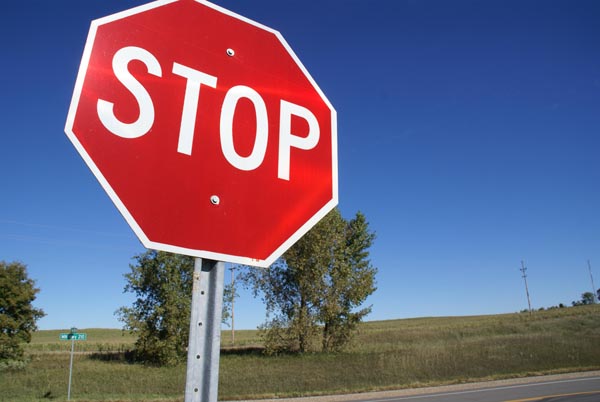Why Stop Signs Have Eight Sides

That’s a stop sign. The dead giveaway? The big word “STOP” on what appears to be a sign. But there’s something weird about the stop sign, at least relative to other signs: the number of sides it has. Most signs are rectangular, as that’s the shape that things like pieces of paper, poster board, and other sign-making materials typically come in. A handful of other signs are round. But an octagon? You almost never see those. How’d this happen?
To start, here’s an oft-overlooked aspect of street signs: the number of sides, by design, carries some information in and of itself. Rectangular signs are informational only; they’ll tell you how fast you can go, how far to a nearby exit, etc. But beyond that, the general rule is that the more sides it has, the more threatening the danger ahead. For example, Do Not Enter signs are typically circles — infinite sides, as Mental Floss notes, because it’s an incredibly bad idea to go the wrong way on the highway. Similarly, railroad crossing signs are also circles, because it is equally dangerous to cross the tracks when a train is coming. (Pentagonal signs are almost exclusively used for “school advance warning signs,” which tell you that you’re in a school zone and kids could be crossing the street. But they’re typically not included in this hierarchy for some reason.) And then there are yield signs — instructing drivers merely to slow down and stop if necessary. These have three sides because there’s less danger ahead.
Toward the top of the sign hierarchy — just below the daunting circular signs — are stop signs, with their eight sides. Stop signs are something that (unlike yield signs) you really can’t afford to miss. (Okay, you probably shouldn’t ignore yield signs, either. But you get the idea.) The design of stop signs was standardized across the United States in 1923. At the time, as Allstate notes on its blog, “the original stop signs weren’t reflective” so we “needed a design that could be easily recognizable at night.” While the powers-that-be could have gone with a 6-, 7-, or 9-sided shape, the octagon won out.
But that’s not quite the whole story. Most Do Not Enter signs are circles printed on rectangles, which makes sense because the sign can be repurposed as, say, a Speed Limit or other rectangular sign if it’s no longer needed for its current purpose. But stop signs are, almost always, cut into their octagonal shape. Why? Because doing so gives us another advantage — drivers approaching the intersection from other directions know what to do. As Allstate further notes, “the octagonal shape makes it easy for drivers traveling in the opposite direction to recognize the sign from the back, which helps prevent confusion.”
Ultimately, that adds up to fewer accidents, which is the whole point of the signs in the first place. The eight-sided traffic indicator is iconic, and its unique shape keeps drivers and pedestrians safe on our shared roadways.
Bonus fact: The man credited with inventing the original stop sign — and for that matter, the crosswalk, one-way street, traffic circles, and more — was an American named William Phelps Eno, born in 1858. He’d live until December of 1945, and over his 87-year life, he created a lot of traffic innovations. But one thing he didn’t do? William Phelps Eno never learned to drive.
From the Archives: They Blue It: Why stop signs are red, and why in one case, they aren’t.
